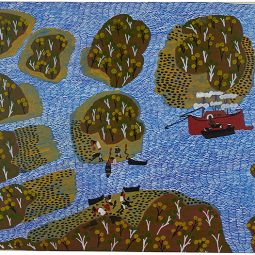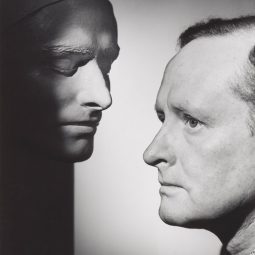In all of the silliness that surrounded the bicentennial celebrations in 1988, in Canberra there was one sober note. On the approaches to the yet-to-be officially opened new parliament house, there appeared a piece of graffiti that in bold white letters proclaimed: ‘White Australia has a black history’. This seemed to sum up more poignantly many of the problems associated with Australia’s nationhood than a dozen cultural programs funded by Australia Council for the Arts.
There has always been heartache and anguish over the marking of Australia Day, which only recently boiled over into open dissent between those who celebrate the founding of a British colony and those who lament dispossession and genocide. It is a dilemma that confronts any institution that attempts to present an account of Australian colonial art.
The National Gallery of Victoria (NGV), in a heroic attempt to cut this Gordian knot for its major colonial art exhibition, decided to stage a two-part presentation – ‘Colony Australia 1770-1861’ and ‘Colony: Frontier Wars’. The first show is situated on the ground floor of the NGV’s Federation Square building and is a sprawling array of over 600 items with some amazing clustering of unique, rarely seen objects drawn from art galleries, museums and libraries throughout the country. The cross-medium displays of colonial art here are pushed to a new level.
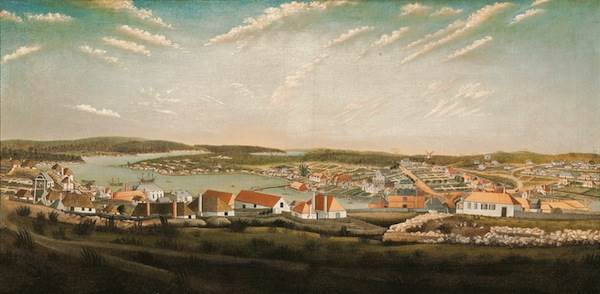
Thomas Watling (1762-1814) (after), Unknown, View of the town of Sydney in the colony of New South Wales c. 1799, oil on canvas, 65 x 133cm. Art Gallery of South Australia, Adelaide. Gift of M.J.M. Carter AO through the Art Gallery of South Australia Foundation in recognition of the abilities of James Bennett to promote public awareness and appreciation of Asian art and culture 2015. Donated through the Australian Government’s Cultural Gifts Program. Courtesy Art Gallery of South Australia, Adelaide and National Gallery of Victoria, Melbourne
Dixson Galleries Collector’s chest from the second decade of the 19th century, complete with its natural history exhibits, vies for space with the oil painting after Thomas Watling’s View of the town of Sydney in the colony of New South Wales (c. 1799) from the Art Gallery of South Australia and a panorama of Melbourne in 1841 that previously I have only seen in reproductions. Unique and rarely seen photographs include those by George Goodman – possibly the first professional photographer in Australia – as well as a set of Douglas Kilburn’s daguerreotypes of Indigenous people in Victoria, the first such photographic images to be made. This all-inclusive, non-hieratical approach introduces a host of new artists, including many women, who recorded visual information about the emerging antipodean colonies from Captain Cook’s visit through to the 1860s.
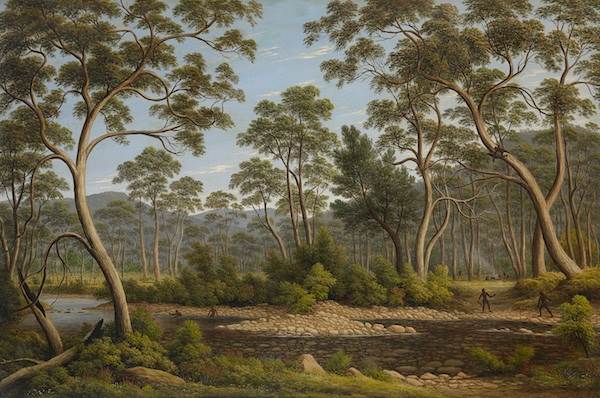
John Glover, The River Nile, Van Diemen’s Land, from Mr Glover’s farm, 1837, oil on canvas, 76.4 x 114.6cm. National Gallery of Victoria, Melbourne Felton Bequest, 1956
It is a dense hang, as is appropriate for its time, where art was part of a cabinet of curiosities, a record of natural history and propaganda for the success of imperial expansion in the Pacific and rarely sought to simply make an aesthetic statement. Virtually all of the icons of early colonial art are on display with the glowing John Glovers, Nicholas Chevalier’s carefully crafted landscapes, Eugene von Guérard’s slices of the sublime and the spirited democratic images of ST Gill. Together with this, and perhaps more satisfying, is the inclusion of the unusual, weird and unexpected, including taxidermied specimens, leg irons from Port Arthur, colonial garments, rare books, manuscripts, drawings and loads of fabulous prints.
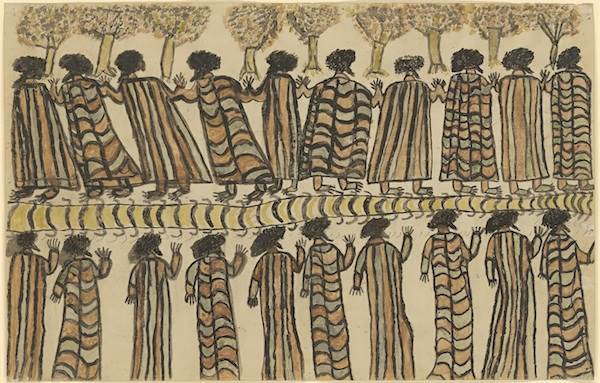
William Barak, Wurundjeri c. 1824–1903, Figures in possum skin cloaks, 1898, pencil, wash, charcoal solution, gouache and earth pigments on paper. 57 x 88.8cm (image and sheet). National Gallery of Victoria, Melbourne. Purchased, 1962
‘Frontier Wars’, the Aboriginal show, is considerably smaller upstairs, and includes fewer surprises. Although the usual suspects are present amongst the so-called ‘urban Indigenous artists’, including strong work by Julie Gough, Brook Andrew, Maree Clarke, Ricky Maynard, Marlene Gilson, Gordon Bennett and Christian Thompson, the most memorable pieces are the wondrous collection of Aboriginal shields – which also introduce the colonial exhibition downstairs; one of the few visual links between the two shows. The well-known 19th century drawings by William Barak and Tommy McRae show Indigenous artists commenting on their heritage and observing the newcomers, while a number of non-Indigenous artists, including ST Gill, Arthur Boyd, Noel Counihan and photographer J. W. Lindt, reflect on black/white race relations.
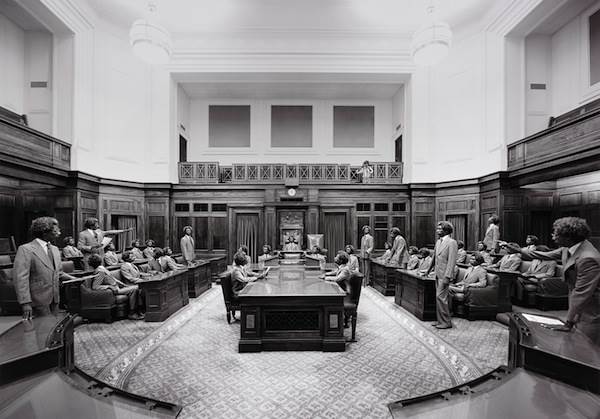
Michael Cook, Senate, 2014, no. 5 from the ‘Majority Rule’ series 2014, inkjet print, ed. 8/8, 84 x 120cm. National Gallery of Victoria, Melbourne. Yvonne Pettengell Bequest, 2014 © Michael Cook. Courtesy the artist and National Gallery of Victoria, Melbourne
One of the most hauntingly memorable pieces is a series of inkjet prints by the Brisbane-based photomedia artist of Bidjara heritage, Michael Cook, who reimagines Australia as a place where Indigenous people make up 96 percent of the population. The simple inversion of the status quo effectively poses the question: how would you feel if you had to walk in the shoes of an Indigenous person in contemporary Australian society?
The catalogue does indicate the thinking behind most aspects of the exhibition where, in many sections, compositions on non-Indigenous art are juxtaposed with a thematically related Indigenous essay. In the exhibition, the physical distance and the existence of two discrete shows make some of the conceptual links less immediately apparent. It is always a challenge to tell two sides of a story simultaneously and to do this in a scholarly, beautiful and convincing manner.
Sasha Grishin works internationally as an art historian, art critic and curator.
National Gallery of Victoria: NGV Australia
Colony: Australia 1770-1861, until 15 July, 2018
Colony: Frontier Wars, until 2 September, 2018
Melbourne
